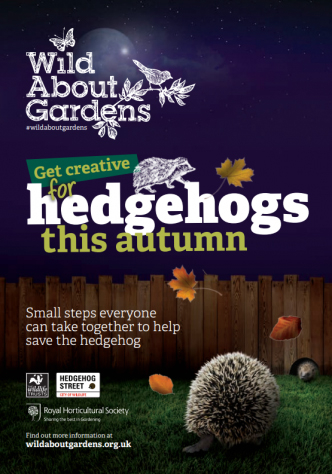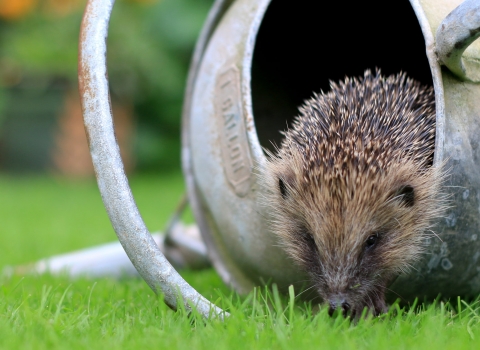They are disappearing from our countryside as fast as tigers are worldwide.
Small, round, brown and famously covered in spines, the hedgehog is one of the most familiar of Britain's wild mammals. The once common hedgehog is now under threat from development and habitat loss caused by the reduction of hedgerows and increase in intensification of our agricultural landscapes.
In just the last 10 years, hedgehog numbers have fallen by 30%, and there are now thought to be fewer than one million left in the UK. So we need your help - make your garden a hedgehog haven.

Download your guide to helping hedgehogs
Small, round, brown and famously covered in spines, the hedgehog is one of the most familiar of Britain's wild mammals.
Make your garden a hedgehog haven
Hedgehog highways
Hedgehogs need to be able to roam far and wide in search of food, mates and nesting sites. Get together with your neighbours to cut a 13cm2 (5in2) hole in your fence or dig a channel beneath garden boundaries to connect your gardens. You can download advice about how to do this and record your hedgehog hole at hedgehogstreet.org.
Keep an eye out for neighbours doing work on their gardens, or using fencing contractors - this is the perfect opportunity to get a hedgehog hole put in and influence connectivity.
Provide nesting sites
Log and leaf piles, wilderness areas and purpose-built hedgehog homes make great places for hedgehogs to nest and hibernate.
Fallen leaves also make the perfect nesting material, so make sure you don’t clear all of these away!
Try to pile these in quiet, undisturbed corners of your garden to allow hedgehogs a safe, secure area to breed and hibernate.
Say no to slug pellets
Hedgehogs hoover up over 100 invertebrates, such as snails, slugs and worms every night, so no need to use poisonous slug pellets!
Cover drains and gullies
Hedgehogs have poor eyesight but are quite curious, meaning they fall into holes and get stuck, so make sure you cover up any open drains and gullies. If you have a pond, make sure you provide an access point so that hedgehogs can climb back out - this can be achieved by using a ramp or placing some stones at one end.
Think about hedgehogs at bonfire time
Every year numbers of hedgehogs die or suffer injuries due to bonfire piles not being not checked before being lit. To help prevent hedgehogs and other wildlife from suffering, it is advised by The British Hedgehog Preservation Society to avoid building your bonfire until the day it is going to be lit - this will reduce the chances of hedgehogs taking up residence in the bonfire pile for hibernation. Always make sure you build your bonfire on clear ground (not on top of leaf litter) and don't forget to check your bonfire before lighting too!

